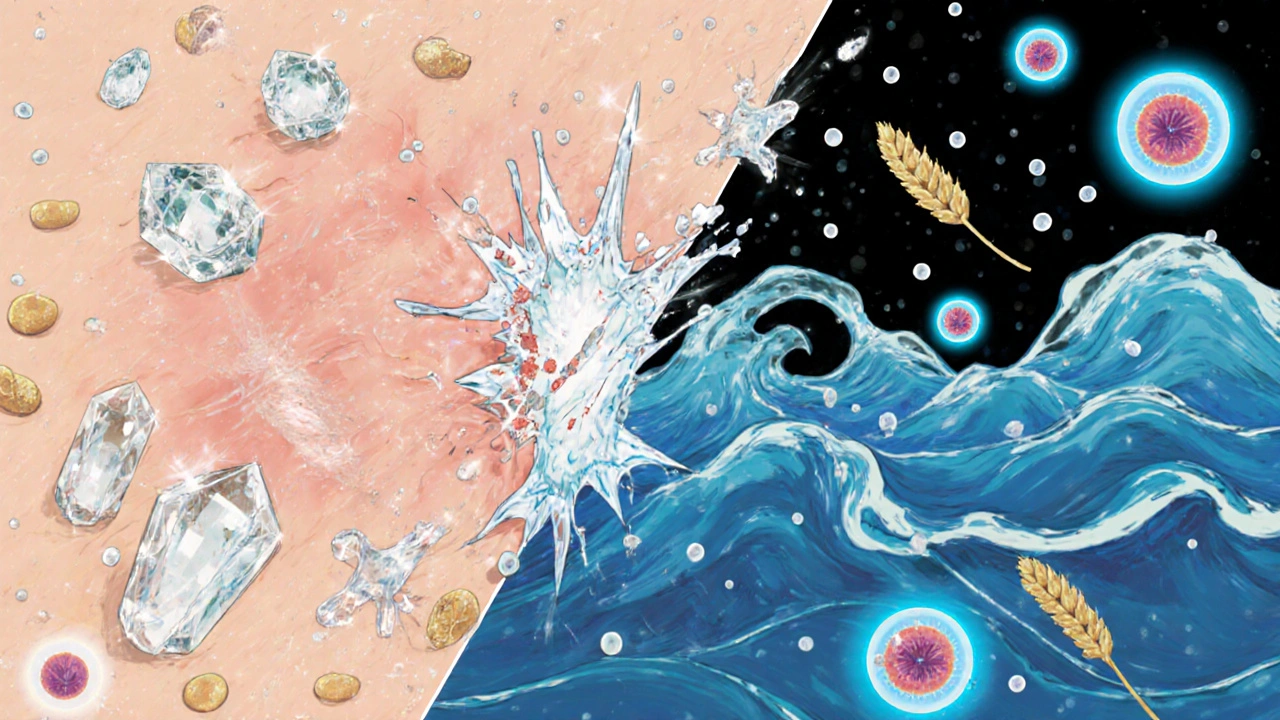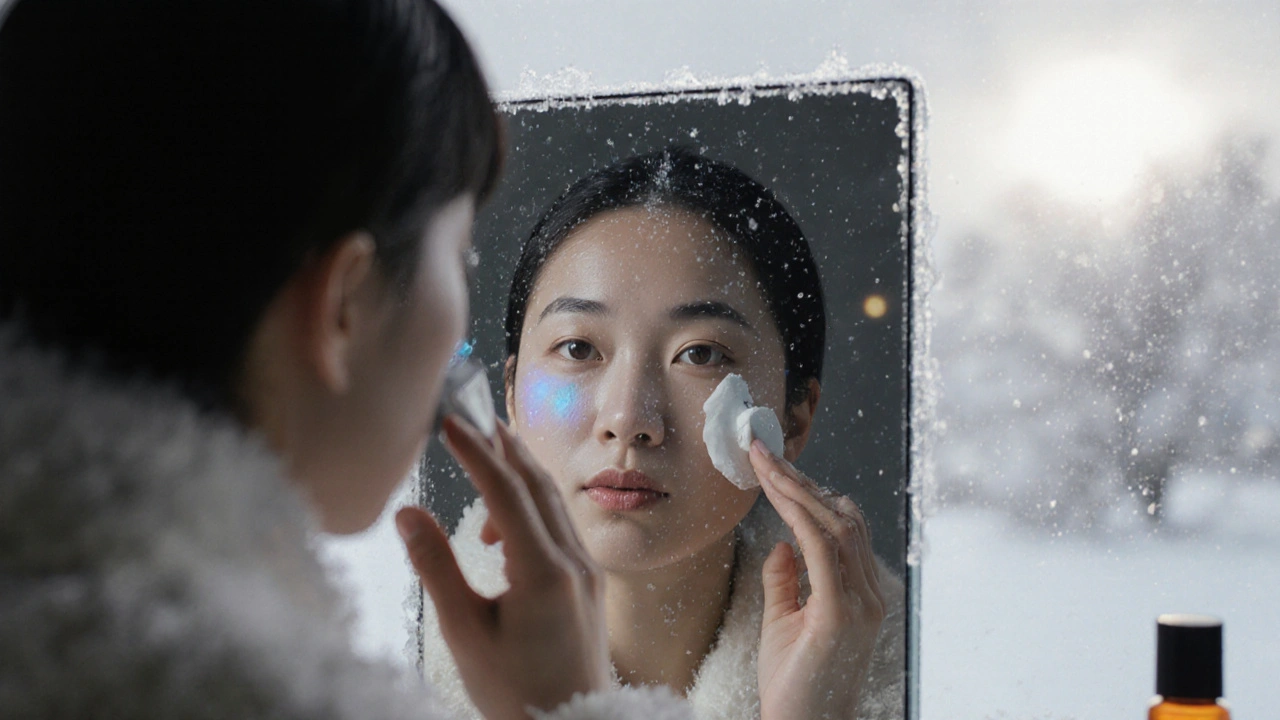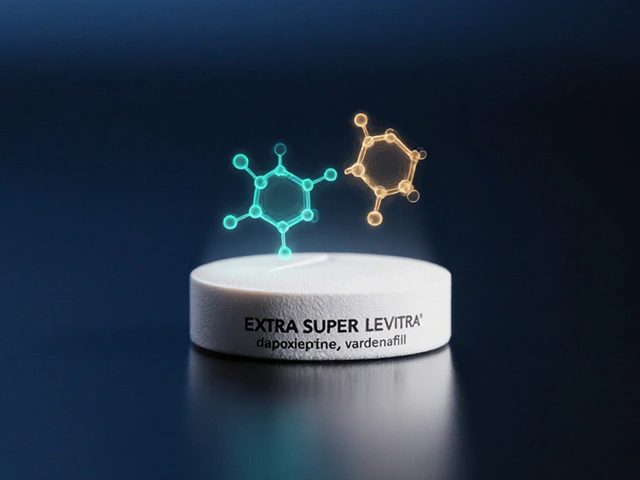Winter turns skin into a battlefield. Cold air, indoor heating, and wind strip away moisture, leaving cheeks red, flaky, and irritated. If you’ve ever woken up with a stinging, tight face after a night of forced-air heat, you know it’s not just dryness-it’s inflammation. That’s where azelaic acid steps in. Unlike heavy creams that sit on the surface, azelaic acid works from within to calm redness, fight bacteria, and repair your skin barrier-all without clogging pores or causing winter-specific irritation.
What azelaic acid actually does to your skin
Azelaic acid is a naturally occurring compound found in grains like barley and wheat. But the version you use on your face is lab-made for potency and purity. It’s not a scrub, not a peel, and not a miracle cure. It’s a gentle, multi-tasking ingredient that targets three big winter skin problems at once: redness, uneven texture, and acne flare-ups.
Studies show azelaic acid reduces inflammation by blocking certain enzymes that trigger redness and swelling. In clinical trials, people with rosacea saw up to a 50% reduction in facial redness after 12 weeks of using 15% azelaic acid cream twice daily. That’s not a guess-it’s backed by data from the Journal of the American Academy of Dermatology. It also slows down the overproduction of skin cells that lead to rough patches and clogged pores, which is why it’s so effective for winter acne. Cold weather slows your skin’s natural turnover, so dead cells pile up. Azelaic acid helps clear them out without drying you out.
Why it beats other acids in winter
Everyone’s talking about glycolic, salicylic, and lactic acids this season. But here’s the catch: those acids are exfoliants. They strip the outer layer of skin to reveal smoother skin underneath. Sounds good-until your skin is already compromised from winter. Glycolic acid can cause stinging, peeling, and even burns on sensitive, dehydrated skin. Salicylic acid, while oil-soluble, can still leave skin feeling tight and flaky when humidity is low.
Azelaic acid doesn’t peel. It soothes. It doesn’t increase sun sensitivity like some acids do, which matters even in winter-UV rays still damage skin on cloudy days. And unlike retinoids, which can cause winter flares of dryness and irritation, azelaic acid actually helps rebuild your skin’s natural moisture barrier. It boosts ceramide production, the lipids your skin needs to hold onto water. Think of it as a repair crew, not a demolition team.
Real winter skin problems it fixes
Let’s get specific. What does azelaic acid actually solve when the thermometer drops?
- Chapped, red cheeks: Common in people with rosacea or sensitive skin. Azelaic acid reduces the visible redness and calms the burning sensation.
- Winter acne: Thickened sebum and trapped dead skin cells lead to small, stubborn bumps. Azelaic acid unclogs pores and kills acne-causing bacteria without overdrying.
- Post-inflammatory hyperpigmentation: After a breakout or irritation, dark spots linger. Azelaic acid lightens these spots naturally, without bleaching or harsh chemicals.
- Itchy, flaky skin around the nose and mouth: Often mistaken for eczema. Azelaic acid’s anti-inflammatory action reduces scaling and restores skin balance.
One woman in her early 30s, who used to dread winter because her cheeks turned bright red every time she went outside, started using azelaic acid cream in November. By January, she stopped wearing foundation just to cover redness. She didn’t use a single moisturizer with heavy oils. Just azelaic acid, a simple hyaluronic acid serum, and sunscreen.

How to use it without making things worse
You can’t just slather it on and expect magic. How you use it matters more than the product itself.
- Start slow: Use it every other night for the first week. If your skin stings or turns pink, cut back to twice a week.
- Apply to clean, dry skin: Never layer it over wet skin or right after a toner with alcohol. That’s a recipe for irritation.
- Wait 15 minutes before moisturizing: This lets the acid absorb fully. Then layer on a simple, fragrance-free moisturizer with ceramides or squalane.
- Use sunscreen daily: Even in December. Azelaic acid doesn’t increase sun sensitivity, but damaged winter skin is more vulnerable to UV damage.
- Don’t mix with strong actives: Skip retinoids, vitamin C, and physical scrubs during the first month. Let your skin adjust.
Most people see results in 4-6 weeks. Don’t expect overnight changes. This isn’t a quick fix-it’s a slow, steady repair.
Who should avoid it
Azelaic acid is safe for most skin types, including pregnancy and breastfeeding. But there are exceptions.
- If you have a known allergy to grains (barley, wheat), test it on a small patch first.
- Don’t use it on open wounds, severe eczema flare-ups, or broken skin.
- If you’ve had a bad reaction to topical antibiotics in the past, talk to a dermatologist first.
It’s not for everyone, but for the millions who struggle with winter-triggered redness and acne, it’s one of the few ingredients that actually helps without making things worse.

What to look for when buying
Not all azelaic acid products are created equal. The concentration matters.
- 10-15%: The sweet spot for most people. Available over-the-counter in brands like The Ordinary, Paula’s Choice, and CeraVe.
- 20%: Prescription strength. Used for moderate to severe rosacea or acne. Requires a doctor’s note.
- Avoid products with added fragrance, alcohol, or menthol. They cancel out the benefits.
Check the ingredient list. Azelaic acid should be listed near the top. If it’s buried after water and glycerin, you’re not getting enough to make a difference.
How it fits into your winter routine
Your winter skincare shouldn’t be complicated. Here’s a simple, effective routine:
- Morning: Gentle cleanser → hyaluronic acid serum → azelaic acid cream → moisturizer → sunscreen
- Night: Gentle cleanser → azelaic acid cream → moisturizer
That’s it. No serums, no essences, no five-step routines. Just two key products doing the heavy lifting: azelaic acid to fix the problem, and a simple moisturizer to protect the barrier.
Winter doesn’t have to mean dull, irritated skin. With azelaic acid, you’re not hiding your skin-you’re healing it.
Can azelaic acid make my skin dry in winter?
No, azelaic acid doesn’t dry out skin like other acids do. In fact, it helps strengthen your skin’s natural moisture barrier by boosting ceramide production. If you feel dryness, it’s likely because you’re skipping moisturizer or using harsh cleansers. Pair it with a simple, non-fragranced moisturizer and you’ll see improvement, not irritation.
Is azelaic acid safe during pregnancy?
Yes. Azelaic acid is classified as Category B for pregnancy safety by the FDA, meaning no evidence of harm in animal or human studies. Many dermatologists recommend it over retinoids or hydroquinone for pregnant women dealing with melasma or acne. Always check with your doctor, but it’s one of the safest topical treatments for winter skin changes during pregnancy.
How long until I see results?
Most people notice less redness and smoother texture in 4-6 weeks. For stubborn pigmentation or rosacea, it can take up to 12 weeks. Consistency matters more than frequency. Using it every other night is enough-overuse won’t speed things up and may cause irritation.
Can I use azelaic acid with niacinamide?
Yes, and it’s a great combo. Niacinamide reduces inflammation and strengthens the skin barrier, while azelaic acid targets redness and acne. Apply niacinamide first, wait 5 minutes, then apply azelaic acid. This pairing works well for sensitive, winter-affected skin.
Do I need a prescription for azelaic acid?
No. 10-15% azelaic acid is available over-the-counter and works well for most people. Prescription-strength 20% is only needed for severe rosacea or acne that doesn’t respond to OTC versions. Start with OTC-it’s cheaper, just as effective for mild to moderate issues, and easier to find.






